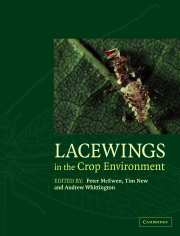Book contents
- Frontmatter
- Contents
- List of contributors
- Preface
- PART 1 Lacewing systematics and ecology
- PART 2 Lacewings in crops
- PART 3 Principles
- PART 4 Case studies
- Introduction to Part 4
- CHAPTER 18 Micromus tasmaniae: a key predator on aphids on field crops on Australasia?
- CHAPTER 19 Preliminary notes on Mallada signatus (Chrysopidae) as a predator in field crops in Australia
- CHAPTER 20 An evaluation of lacewing releases in North America
- CHAPTER 21 Chrysoperla externa and Ceraeochrysa spp.: potential for biological control in the New World tropics and subtropics
- CHAPTER 22 Comparative plant substrate specificity of Iberian Hemerobiidae, Coniopterygidae, and Chrysopidae
- CHAPTER 23 Lacewings in Sardinian olive groves
- CHAPTER 24 Lacewing occurrence in the agricultural landscape of Pianura Padana
- CHAPTER 25 Lacewings and snake-flies in Piedmont vineyards (northwestern Italy)
- CHAPTER 26 Control of aphids by Chrysoperla carnea on strawberry in Italy
- CHAPTER 27 Artificial overwintering chambers for Chrysoperla carnea and their application in pest control
- CHAPTER 28 Lacewings in Andalusian olive orchards
- CHAPTER 29 The green lacewings of Romania, their ecological patterns and occurrence in some agricultural crops
- CHAPTER 30 Biological control with Chrysoperla lucasina against Aphis fabae on artichoke in Brittany (France)
- PART 5 Conclusion
- Taxonomic index
- General index
CHAPTER 27 - Artificial overwintering chambers for Chrysoperla carnea and their application in pest control
Published online by Cambridge University Press: 04 May 2010
- Frontmatter
- Contents
- List of contributors
- Preface
- PART 1 Lacewing systematics and ecology
- PART 2 Lacewings in crops
- PART 3 Principles
- PART 4 Case studies
- Introduction to Part 4
- CHAPTER 18 Micromus tasmaniae: a key predator on aphids on field crops on Australasia?
- CHAPTER 19 Preliminary notes on Mallada signatus (Chrysopidae) as a predator in field crops in Australia
- CHAPTER 20 An evaluation of lacewing releases in North America
- CHAPTER 21 Chrysoperla externa and Ceraeochrysa spp.: potential for biological control in the New World tropics and subtropics
- CHAPTER 22 Comparative plant substrate specificity of Iberian Hemerobiidae, Coniopterygidae, and Chrysopidae
- CHAPTER 23 Lacewings in Sardinian olive groves
- CHAPTER 24 Lacewing occurrence in the agricultural landscape of Pianura Padana
- CHAPTER 25 Lacewings and snake-flies in Piedmont vineyards (northwestern Italy)
- CHAPTER 26 Control of aphids by Chrysoperla carnea on strawberry in Italy
- CHAPTER 27 Artificial overwintering chambers for Chrysoperla carnea and their application in pest control
- CHAPTER 28 Lacewings in Andalusian olive orchards
- CHAPTER 29 The green lacewings of Romania, their ecological patterns and occurrence in some agricultural crops
- CHAPTER 30 Biological control with Chrysoperla lucasina against Aphis fabae on artichoke in Brittany (France)
- PART 5 Conclusion
- Taxonomic index
- General index
Summary
INTRODUCTION
Leather et al. (1993) asked the pertinent question ‘What is overwintering?’ They answered themselves by quoting Mansingh (1971) who defines insect hibernation as ‘a physiological condition of growth retardation or arrest, primarily designed to overcome lower than optimum temperatures during winter or summer’. Mansingh (1971) subclassified insect hibernation into different categories depending on the insect's response to winter conditions. The three different categories are quiescence, oligopause and diapause representing, in sequence, increasingly highly evolved systems of dormancy. The common green lacewing (Chrysoperla carnea) s. lat. can be considered to enter diapause. After Leather et al. (1993) this is characterised by (1) a definite preparatory phase usually initiated by a temperature independent factor such as photoperiod; (2) absence of feeding by the insect during winter; and (3) the return of favourable conditions does not result in immediate termination of diapause – a complex series of events such as accumulation of heat units is required first.
Common green lacewings diapause in large clusters of adult insects. Observed overwintering sites include unheated parts of buildings, barns, the underside of tree bark, and leaf litter (Canard & Principi, 1984), with the choice of site partly determined by sibling species (Thierry et al., 1994). Normally, due to a combination of fluctuating temperature and predation, winter mortality is high (Sengonca & Frings, 1987). However lacewings will colonise artificial overwintering chambers especially designed for the purpose and in these overwinter survival can approach 100% (Sengonca & Henze, 1992).
- Type
- Chapter
- Information
- Lacewings in the Crop Environment , pp. 487 - 491Publisher: Cambridge University PressPrint publication year: 2001
- 4
- Cited by



